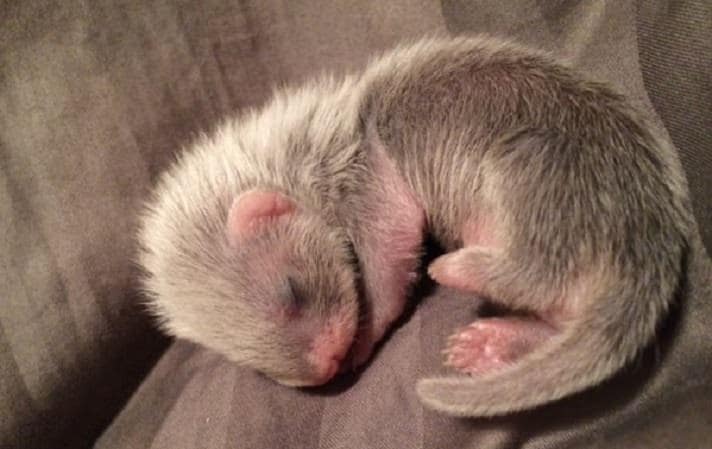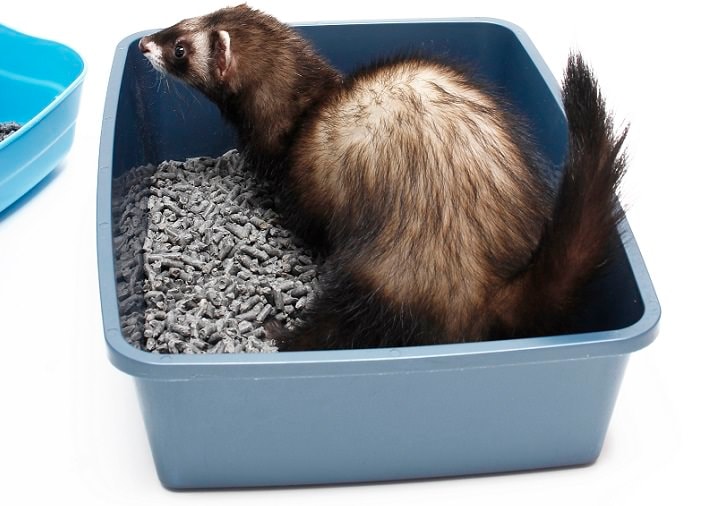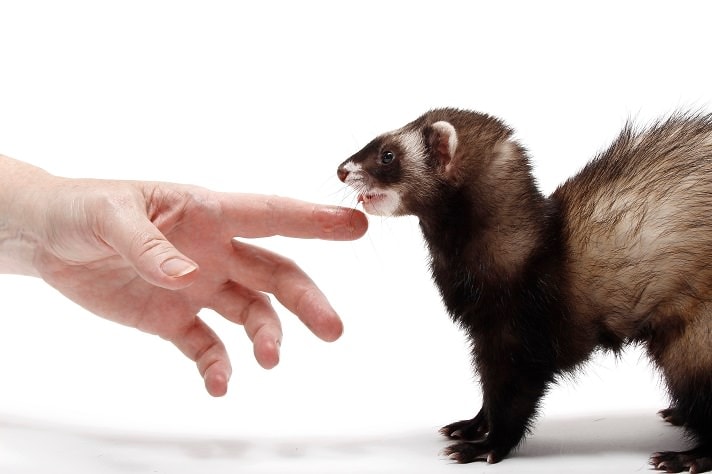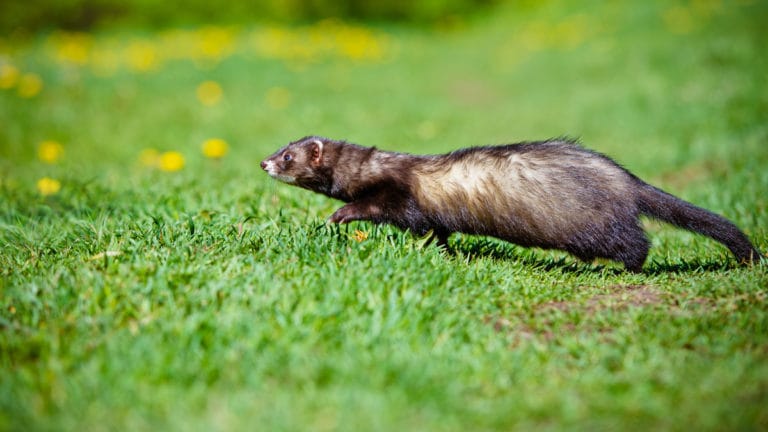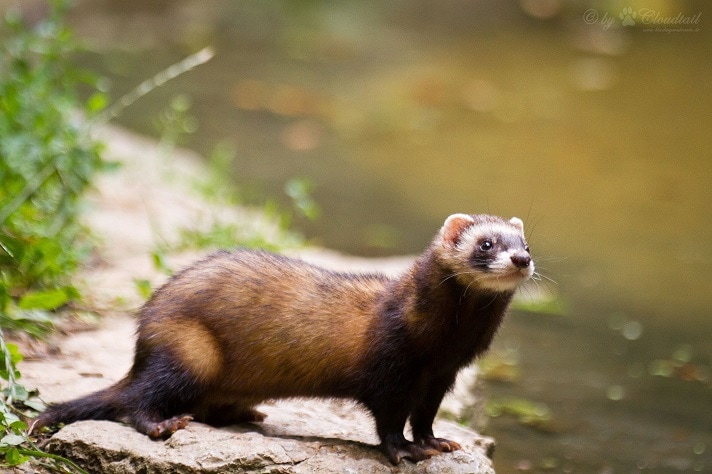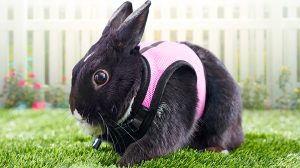Ferret babies are called kits. Kits usually weigh 6 to 14 grams at birth and are about 2 to 2.5 inches long, which is about the size of an adult human’s little finger. They are born with soft baby fuzz as fur. As they get older, their hair gets longer and colors more defined. Champagne, chocolate and light roan colors stay very light, sables gradually turn a dark gray with the hair on their head being a lighter gray. Black sable solids are born with a purple color and get blacker. If their paws have mitts, you can see the white definition on their feet. Albinos are discernible right away, because their eyes are pink and will not show as a dark dot, and they always have pink noses. Nose color varies with other coat colors and includes the colors pink, light brown, mottled and solid black.
Kits grow fast. Below are approximate weights (note that 28 grams equals 1 ounce). Weights vary some, as hobs (intact male ferrets) are usually bigger than jills (intact female ferrets).
- Birth – 6 to 14 grams
- 7 Days – 20 to 32 grams
- 14 Days – 54 to 90 grams
- 21 Days – 100 to 155 grams
- 28 Days – 164 to 224 grams
- 35 Days – 240 to 350 grams
- 42 Days – 260 to 468 grams
Born blind, deaf and without teeth, it takes about three weeks before baby ferrets start to develop their baby teeth. Eyes and ears do not open until about 4 to 5 weeks old. For the first three weeks, kits nurse every couple of hours and sleep. They are totally dependent on their mom, to the point that they need her gentle cleaning for defecating. For the short periods kits are awake, they can be very active and blindly squirm away from mom, sometimes needing her gentle touch to bring them back to the nest. They can be very vocal and there is a definite difference between the peeping sounds of “Hey, where’s the faucet Mom?” to “HELP! I’m cold and scared.”
Each jill differs on how protective she is at delivery. Once kits are established and gaining weight, frequent handling/human contact is good for the kits. A jill will not refuse her kits after being handled by people. In fact, most jills accept another jill’s kits easily. Amusingly, a mother seems to know how many kits she has, counts them, and knows when one is not there. I always show my empty hands to the jill after handling and returning a kit.
Newborn kits have their own distinct baby smell until about 3.5 weeks when they start to eat solids. The musky, milky-like scent is similar to puppy and kitten baby smell. People either like it or they don’t.
An average litter size is 4 to 8, but it can be as large as 14 and small as 1. Jills have five to nine nipples and can only nurse that many at a time. If she has more kits than nipples, she will nurse in shifts by placing the ones not nursing behind her. It’s not uncommon to lose the smallest ferret in a litter, especially if the litter is big, but sometimes the littlest ones can surprise you. Too small of a litter can be a problem too. If only one or two kits are drinking, there may not be enough nursing action to stimulate milk production. The jill may even come back into season losing her milk too. At that point, ferret breeders rely on a foster mom or do around-the-clock hand-feeding. Hand-feeding kits less than 1 to 2 weeks old can be difficult; hand-feeding newborns is next to impossible.
Kits can be very vocal. It’s amazing how loud the peeping is from newborn baby ferrets. At 4 to 12 weeks old, they make a “waahing” noise looking for mom and sometimes even sound like a goose honking. As they get older, they quit making that noise and start doing the familiar “dooking” noise associated with ferrets. Kits are started on a moist soupy mush between 3.5 to 4 weeks old. This soupy mush consists of ground or boiled pieces of meats and kibble soaked in the broth the meat was cooked in along with possibly kitten formula or other additives of the breeder’s choice. Kits are very clumsy when they first start on the mush. They tend to roll around and end up with more on them than in their mouths. The mom spends quite a bit of time cleaning them off, as they look like little piglets rolling in the mud. But within a few days, they are able to eat their fill with no problem.
By 4 weeks of age, they have sharp baby teeth and are very adept at chewing. Ferrets are obligate carnivores, meaning meat-eaters, so they are adapted to start eating meat at a very young age. Many private breeders feed a raw diet and/or feed a whole prey diet. By 6 weeks old, the baby ferrets are weaned and stop nursing. At about 8 to 10 weeks, kits start to get their adult teeth and their baby teeth fall out. Briefly during this time, they actually have two sets of sharp little teeth.
Once the kits start eating their mush, it’s time to learn to use a litter box. This is important as they can go potty on their own and their mom no longer has to assist. I use ferret cages with a recessed litter box so that the kits can just walk right into the litter box; this saves considerably on the mess. Even before their eyes are open, they learn potty habits from their mom and follow by smell where she goes. It’s so adorable to see a little kit without his or her eyes open yet doing the corner potty posture. The look of utter relief on their little faces is priceless.
Playing begins at about 4 to 5 weeks of age. It starts with kits rolling around, attacking and just being ferrets in slow motion. As they get older and steadier on their feet, they play for a period and then fall asleep so soundly that they seem dead, which can be very scary.
Ferrets are usually full grown by 6 to 10 months but are still considered an adolescent until 1 year. Females become mature at 6 to 8 months old while males mature at 8 to 10 months. The average size of full-grown, privately bred ferrets differs from those from a pet store. A full grown jill weighs 1.5 to 3 pounds and an average hob weighs 3 to 6 pounds. Privately bred ferrets that are allowed to mature naturally are usually about a third larger than average pet store ferrets.
Breeding ferrets should not be undertaken lightly nor done indiscriminately. There are so many things that can go wrong. Timing is everything. Jills can die of aplastic anemia if not taken out of season or spayed. Hobs must be in season to breed and usually are for about six months per year. Jills that are bred or taken out of season can develop uterine infections. They can have difficulty delivering, need a C-section or kits can die during pregnancy, go septic and kill her. Not all jills produce milk and some will even kill their kits. Ultimately, you could lose your jill and all kits.
Anyone who considers breeding ferrets should first own ferrets for a period of time to determine if they are a long-term pet for them. In addition to owning ferrets, potential ferret breeders need to do considerable research, be part of a good support group, be financially prepared, have a breeding plan and know the genetic and health history of the jills and hobs used for breeding. It’s best to have possible homes lined up for the kits in advance. There is much more to be considered, but breeding ferrets is a separate topic.
Want to know more about ferrets? Check out:
- 10+ Ways To Keep Ferrets Happy
- Revealing The Ferret Personality Types
- 10 Steps For Fun, Safe Outdoor Walks With Ferrets
Scarlett A. Gray-Saling is a longtime ferret breeder and operator of Scarlett’s Happy Dooker’s ferretry.
Feature Image: Scarlett A. Gray-Saling
Share:
